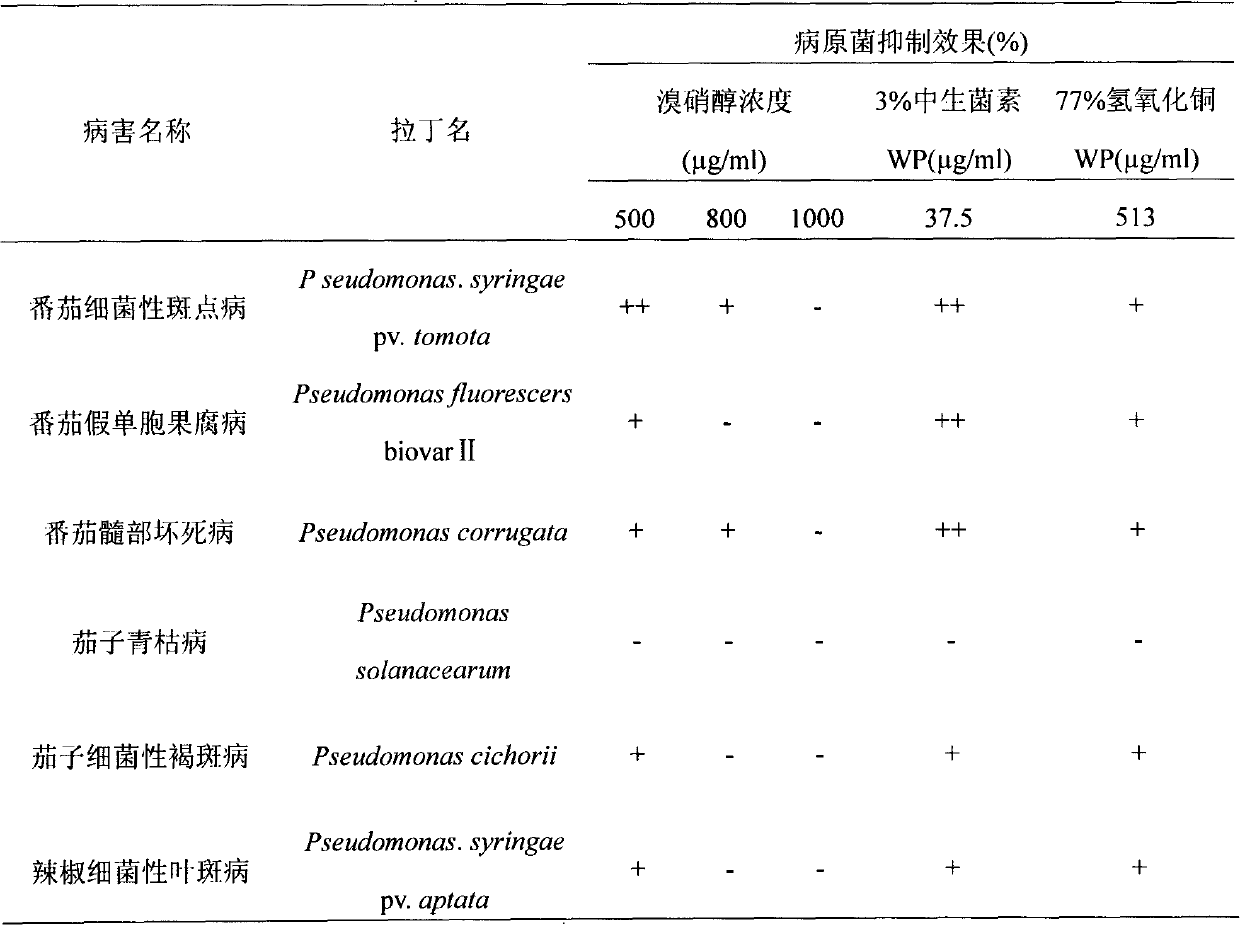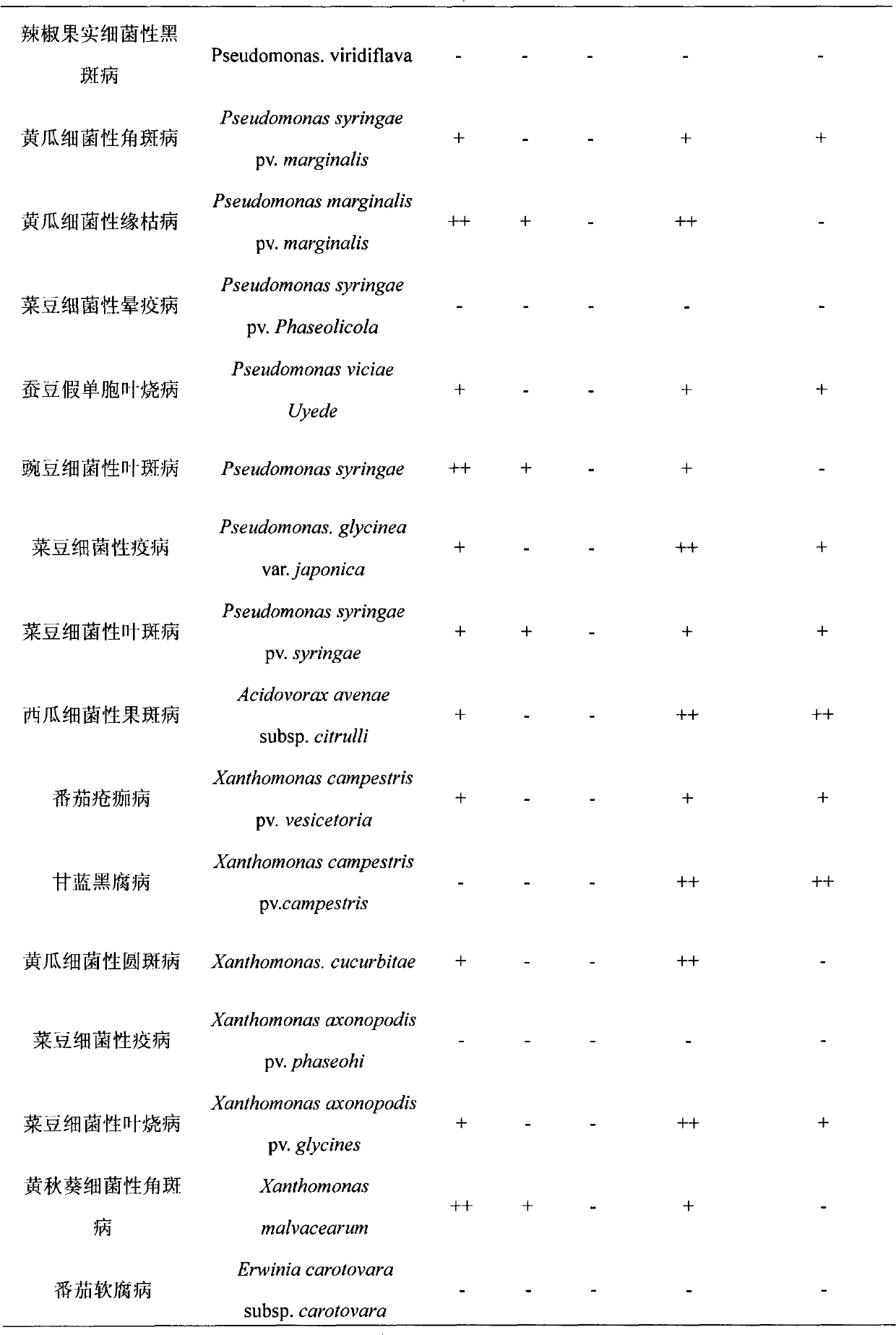Application method for bactericide controlling vegetable bacterial diseases
A vegetable disease and bacterial technology, applied in the field of phytochemical protection, can solve the problems of no reports, reduce vegetable bacterial diseases, short residual time of degradation products, etc., and achieve the effect of low cost and broad market prospects.
- Summary
- Abstract
- Description
- Claims
- Application Information
AI Technical Summary
Problems solved by technology
Method used
Image
Examples
Embodiment 1
[0031]According to the results of the antibacterial activity of different concentrations of bronopol on pathogenic bacteria in the plate test, the agent has obvious inhibitory effect on bacteria, and the concentration of bronopol at 500 μg / ml or 800 μg / ml cannot completely Inhibit the growth of all strains in the test, but when the concentration of bronopol reached 1000 μg / ml, all the strains in the test were completely inhibited, which shows that bronopol has obvious inhibitory effect on vegetable pathogenic bacteria at a concentration of 1000 μg / ml , while the control agents 3% Zhongshengmycin WP and 77% Copper Hydroxide WP could not achieve complete inhibitory effect at the recommended dosage.
[0032] Table 1 The inhibitory effect of different concentrations of bronopol on pathogenic bacteria
[0033]
[0034]
[0035]
Embodiment 2
[0037] According to the result judgment (table 2) in the in vivo test of different concentrations of bronopol, its control effect, when the concentration of bronopol exceeded 1000 μ g / ml, the control effect of various diseases in the test was more than 85%, and compared with 1500 μ g / ml There was no significant difference in the control effect under the concentration, indicating that at the concentration of 1000 μg / ml, bronopol had a broad-spectrum bactericidal effect on vegetable bacterial diseases, and the control effect was significantly higher than that of the control agents 3% Zhongshengmycin WP and 77 % copper hydroxide wettable powder.
[0038] Table 2 Investigation of results of live pot experiments on bacterial diseases under different concentrations of bronopol
[0039]
[0040]
[0041]
Embodiment 3
[0043] In the field drug efficacy test, the dosage of bronopol was 30-45g / mu, and the dosage of the reference drug 77% copper hydroxide WP was 30g / mu according to the recommended dosage. The whole plant was sprayed at the early stage of the disease. The test strains included: Pseudomonas Eggplant bacterial wilt caused by Pseudomonas solanacearum (Smith) Smith in the genus Pseudomonas and by Acidovorax avenae subsp. citrulli in the genus Acidovorax Bacterial fruit spot of watermelon caused by Xanthomonas xanthomonas Bacterial round spot of cucumber caused by X. cucurbitae (Bryan) Dowson, Erwinia spp. Tomato soft rot caused by Erwinia carotovara subsp. carotovara (Jones) Bergey et al. in Erwinia, and by Clavibacter in Michigan Tomato canker caused by Clavibacter michiganense subsp. michiganensis (Smith) Davis et al. In the field test of five diseases of eggplant bacterial wilt, watermelon bacterial fruit spot, cucumber bacterial round spot, tomato soft rot and tomato canker, wh...
PUM
 Login to View More
Login to View More Abstract
Description
Claims
Application Information
 Login to View More
Login to View More - R&D
- Intellectual Property
- Life Sciences
- Materials
- Tech Scout
- Unparalleled Data Quality
- Higher Quality Content
- 60% Fewer Hallucinations
Browse by: Latest US Patents, China's latest patents, Technical Efficacy Thesaurus, Application Domain, Technology Topic, Popular Technical Reports.
© 2025 PatSnap. All rights reserved.Legal|Privacy policy|Modern Slavery Act Transparency Statement|Sitemap|About US| Contact US: help@patsnap.com



